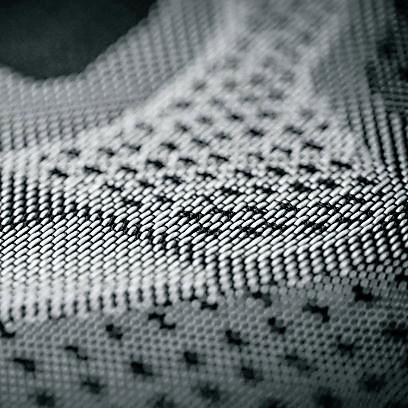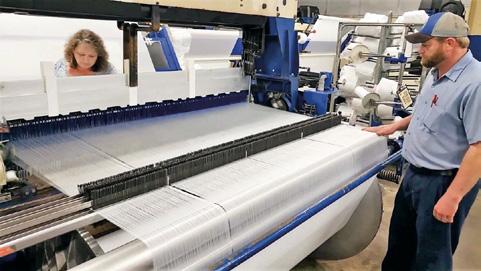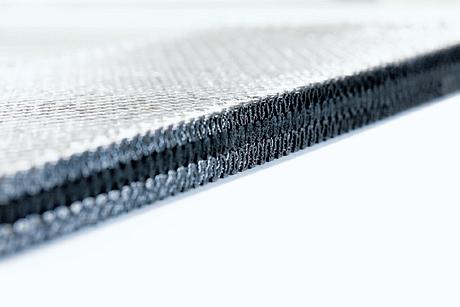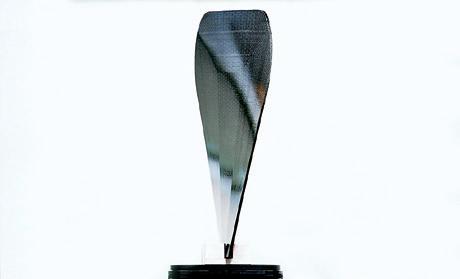4 minute read
3D Weaving - The Future Weaving
3D Weaving
The Future Weaving with a wide range of applications

Weaving is a method of textile production in which two distinct sets of yarns or threads are interlaced at right angles to form a fabric or cloth. With passing time, there has been a technological shift in weaving machines and patterns.
ProWeave: Recently, Hong Kong-based company Texon has introduced a patented jacquard weaving technology called “ProWeave.” The new technology makes it possible to seamlessly integrate functional and design weaves into a single sheet of material. It enables the production of continuous woven substrates with the zonal features product designers want and exactly where they want them, the company says, allowing fabrics for the footwear, apparel, fashion, and luxury goods industries to be completely reimagined.
Reimagining fabrics for the footwear, apparel, fashion, and luxury goods industries, ProWeave transforms how performance fabrics are made and how they look, feel, and function. Creating different elasticity, tenacity, and abrasion zones within the same weave, ProWeave can help brands bring new creative concepts to life. The innovative technology effortlessly blends diverse yarn thicknesses, weights, and fabric references– creating intricately designed fabrics with distinctive gradient, rib, waffle, color, stretch, transparency, and 3D effects.
Creating different elasticity, tenacity, and abrasion zones within the same weave, ProWeave can help brands bring new creative concepts to life and the technology diverse yarn thicknesses, weights, and fabric references to be effortlessly combined to create a distinctive gradient, rib, waffle, color, stretch, transparency, and 3D effects.
Texon can provide ProWeave for mass production projects, with multiple designs for uppers, garments, and accessories on one roll. The business can also offer ProWeave in small quantities for series or
limited-edition collections. ProWeave is produced at Texon’s plant in Prato, Italy, and at the company’s newest manufacturing center in Vietnam, which opened in mid-2020. With the ability to mix different high tenacity, flame retardant, stretch, and TPU coated yarns to create hard-wearing materials, Texon also sees significant opportunities for ProWeave in industrial footwear and safety apparel applications.
WEAV3D: The WEAV3D process combines weaving and composite consolidation into an automated, continuous process that reduces waste, cycle times, and material handling costs. WEAV3D is a company based in Norcross, Georgia. The company’s ‘Rebar for Plastics’ approach improves part stiffness and strength while minimizing weight, enabling innovations in the automotive and construction markets at a fraction of the cost and cycle time associated with traditional composite manufacturing.
Conventional composite manufacturing methods also rely on energy-intensive curing processes, which translate to high embodied energy, or energy per unit mass, and contribute to the overall CO2 footprint of the finished part. WEAV3D was previously awarded a $224,718 NSF SBIR Phase I grant to investigate alternative thermal consolidation methods to reduce embodied energy by at least 60% relative to the current infrared consolidation baseline. Of all the consolidation techniques evaluated, ultrasonic welding showed the best combination of speed, efficiency, and weld quality.
Olympic uniforms: Alexander County mill weaves fabric for Olympic uniforms. Alexander County mill is
weaving fabric to be used in the uniforms of American athletes competing at the 2022 Winter Olympics in Beijing. Schneider Mills has already finished about 30,000 yards of the 48,000 yards of woven fabric that will be used in the uniforms, said Curt Parker, Schneider’s vice president of operations. Schneider Mills is a weaver of synthetic fiber goods for various end uses, from manufacturing fabric for parachutes, automotive airbags, surgical bandages, tents, flags, and various other military uses. The company produced materials used in the parachute for the Mars Rover.
3D weaving: In 3-dimensional weaving, the goal is to create thickness by stacking multiple layers. On
conventional weaving machines, the layering is achieved by dividing the warp into multiple, separate sets. On a given pass through the warp, the weft will not intersect the warp threads that belong to a different layer. Recently, there has been a surge in using 3D weaving. Fabric producer Antich and Sons have achieved a step-change in its manufacturing capability to produce finished 3D multi-layer woven preforms for advanced composites used in the aerospace and automotive industries through a project at the University of Sheffield Advanced Manufacturing Research Centre (AMRC).
The 3D weaving of carbon fiber is a cost-effective method for producing high-quality, damage tolerant, large-scale, and high-thickness laminates for liquid resin injection processes to make lightweight composite materials. However, to create composite preforms suitable for resin transfer molding, several additional procedures are required to achieve widespread technology adoption. So, the future is 3D weaving for various applications.






